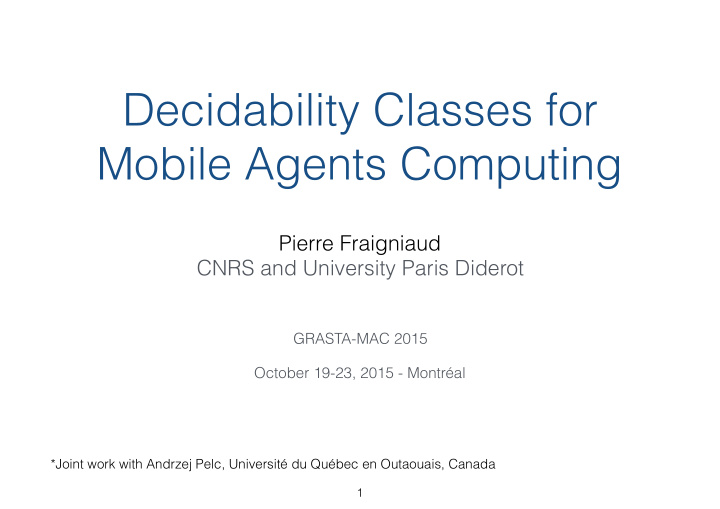



Decidability Classes for Mobile Agents Computing Pierre Fraigniaud CNRS and University Paris Diderot GRASTA-MAC 2015 October 19-23, 2015 - Montréal *Joint work with Andrzej Pelc, Université du Québec en Outaouais, Canada 1
Algorithmic achievements in mobile computing Many algorithms for ‘construction/coordination’ tasks: rendezvous exploration intruder detection/search/capture fault-tolerance (byzantine agents) ‘black-hole’ search etc. 2
but… 3
Verification 1. Designing a program together with its proof 2. Verifying a given program a posteriori 3. Verifying the execution at runtime: Runtime verification 4
Results I would love to see in the context of mobile computing Theorem (Naor&Stockmeyer, 1995). If there exists a distributed randomized construction algorithm for L running in O(1) rounds, then there exists a distributed deterministic construction algorithm for L running in O(1) rounds. *** Require L ∈ LD to be locally decidable! *** 5
A Scenario of Is the system satisfying Application predicate P? 6
Construction vs. Decision Language: L = {w ∈ {0,1}* satisfying predicate P} Construction: Given x, compute y s.t. (x,y) ∈ L Decision: Given x, decide whether x ∈ L (yes/no) Applications: • Self-reducibility for NPC languages in sequential computing • Derandomization theorems in distributed computing • Monitoring (distributed) systems 7
Distributed Decision Rules Yes! Yes! Yes! Yes! Yes! ✔ Yes! No! Yes! Yes! Yes! ✖ 8
Decision tasks Is this network Is there an intruder planar? in this building? Is there an exit in this labyrinth? Network monitoring 9
Decision classes (computability) Configuration: C = (G,S,x) with S ⊆ V(G) and x: S ⟶ {0,1}* Language: L = { configurations } MAD = M obile A gent D ecision MAD = { L | ∃ mobile agent algorithm A deciding L } A decide L if and only if, for every configuration C: C ∈ L ⇔ every agent outputs yes 10
Deciding vs. verifying Wiles' proof Fermat's conjecture Decide Verify Certificate Oracle or Proof 11
P vs. NP NP = Non-deterministic Polynomial L ∈ NP iff there is a poly-time algorithm A such that: • x ∈ L ⇒ ∃ c, A(x,c) accepts • x ∉ L ⇒ ∀ c, A(x,c) rejects c is the certificate, or the proof. 12
MAD vs. MAV MAV = M obile A gent V erification L ∈ MAV iff there is a mobile agent algorithm A such that: • (G,x) ∈ L ⇒ ∃ c, A(G,S,x,c) leads all agents to accept • (G,x) ∉ L ⇒ ∀ c, A(G,S,x,c) leads at least one agent to reject c: S ⟶ {0,1}* is the certificate, or the proof A is a verifier, while the certificates are given by a prover. 13
Applications • Composition of algorithms Output Input Black box Certification • Termination (e.g., in self-stabilization) (y u ,c u ) (y v ,c v ) (y i ,c i ) (y w ,c w ) 14
Oracles C L = class C with an oracle for language L Example: P SAT = poly-time with TM using an oracle for SAT. Extend to C X = U L ∈ X C L Typical oracles for MAD and MAV: #nodes #agents upper-bounds on n,k,… 15
A Scenario of Application 16
Synchronous Mobile Agents in Anonymous Networks 2 2 3 1 1 1 Network: 2 1 2 3 2 1 + Agents: Communication whenever Mobile TM at the same node 17
MAD vs. MAV & co-MAV • treesize ∈ MAD (perform DFS for 2(n-1) steps) • tree ∉ MAD (even path ∉ MAD 1 ) • tree ∈ MAV (certificate = n) • nontree ∈ co-MAV 18
Views and Quotient quotient(G) = G/view 1 2 1 2 1 2 3 3 2 1 2 1 2 1 2 1 (c) 1 3 <<< Non Isomorphic Graphs 2 3 2 1 1 1 2 2 2 2 3 3 Same Quotient 1 1 1 1 2 2 19
Two Central Languages (i.e., Tasks) • quotient = { (G,S,H) | G/view = H } • nonquotient = { (G,S,H) | G/view ≠ H } nonquotient ∈ MAV (views at distance |G/view|) • accompanied = {(G,S,x), |S|>1} accompanied ∈ MAV (lead all nodes to same node) 20
Main Result L 1 x L 2 = { (G,S,( i ,x)) | i ∈ {1,2} and (G,S,x) ∈ L i } Theorem (F, Pelc, 2012). accompanied x nonquotient is MAV-complete (for ‘natural’ reduction). Corollary nonquotient is MAV 1 -complete. 21
Case of a Single Agent Δ 1 MAD map 1 MAD #nodes 1 MAD nonquotient 1 MAV 1 co-MAV 1 MAD 1 22
Equalities and Separations MAV 1 ∩ co-MAV 1 = MAD 1 (test all certificates) MAV 1 U co-MAV 1 ⊂ MAD 1 NonQuotient cycle x nosun ∉ MAV 1 U co-MAV 1 cycle x nosun ∈ MAD 1 NonQuotient 23
More separations MAD 1 nonquotient ⊂ MAD 1 #nodes ⊂ MAD 1 map ⊂ All 1 { u v 24
Concluding remarks Objective: developing an embryo of computability theory for mobile agent computing. Formalize the informal notion of ‘initial knowledge’ Open problems: • Construction vs. decision for mobile agent computing? • Complexity theory? (What is the right measure?) • Role of randomization? P. Fraigniaud and A. Pelc, Decidability Classes for Mobile Agents Computing , In LATIN 2012. E. Bampas and D. Ilcinkas, Problèmes vérifiables par agents mobiles , In AlgoTel 2015. 25
Recommend
More recommend